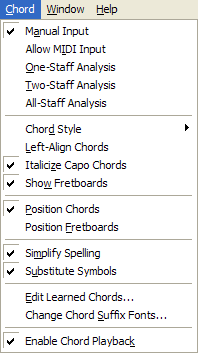|
L'aide française est disponible au format PDF en cliquant ici (ou dans le Menu "Démarrer", Finale 2010, Documentation PDF française)
Le tutoriel français est disponible au format PDF en cliquant ici.
La mise à jour de l'aide française au format HTML sera disponible prochainement.
|
Traduction française :

|
Chord menu

How to get there
Click the Chord Tool  to make the Chord menu appear.
to make the Chord menu appear.
What it does
Use the chord menu to specify how you want to add, define, or change chord symbols and fretboard diagrams.
Manual Input allows you to either type chord symbols directly into the score, or define them manually. Allow MIDI Input allows you to specify chords by playing them on a MIDI keyboard. The three analysis methods allow you to tell Finale to analyze notes that already exist in the score and add the appropriate chord symbols automatically based on the harmonic analysis. You can analyze one, two (e.g. a grand staff), or all staves in the score at a time.
Select a command in the Chord Style submenu to change the display style for all your chord symbols. You can choose Standard, German, European, Roman, Nashville, Scandinavian or Solfeggio spelling styles.
Use the Substitute Symbols command to enter alterations (sharps or flats) and diminished symbols.
If you are entering chord symbols using any of the automatic methods and Finale doesn’t recognize a chord, it will display the Unknown Chord Suffix dialog box. If you click Let Finale Do It, Finale will attempt to create the proper chord suffix and place the chord symbol in the score. For most chord qualities (M, m, Maj7, m7, dim, m7f5, aug, sus4, and so on), Finale will arrive at the right solution. See Unknown Chord Suffix dialog box.
For the few chords Finale doesn’t identify correctly, you can “teach” them to Finale as new chords. When you see the Unknown Chord Suffix dialog box, click I’ll Do It to access the Chord Suffix Editor dialog box; then create the chord symbol (and its suffix, if necessary) in the Chord Definition dialog box (see Chord Definition dialog box). The next time you play the chord (in any octave and any voicing), Finale will know what chord symbol to display. (This custom teaching feature is “root-specific,” however; if you only teach Finale to recognize a C major sixth chord in the key of C, it will only recognize major sixth chords built on C. But it will recognize, for example, a Gmaj6 in the key of G and an Amaj6 in the key of A.) See Unknown Chord Suffix dialog box and Chord Definition dialog box.
If you're entering chord symbols using Manual Input, Finale lets you type your chord symbols directly on screen -- or type the chord symbols in the Chord Definition dialog box. If you're typing chord symbols and Finale doesn't recognize a chord, it will give you the option of creating the suffix. If you click OK, Finale will display the Chord Suffix Editor dialog box with the suffix already entered. You can make changes then return to the score with the new suffix placed on the chord symbol. See To type chord symbols into the score for more details.



